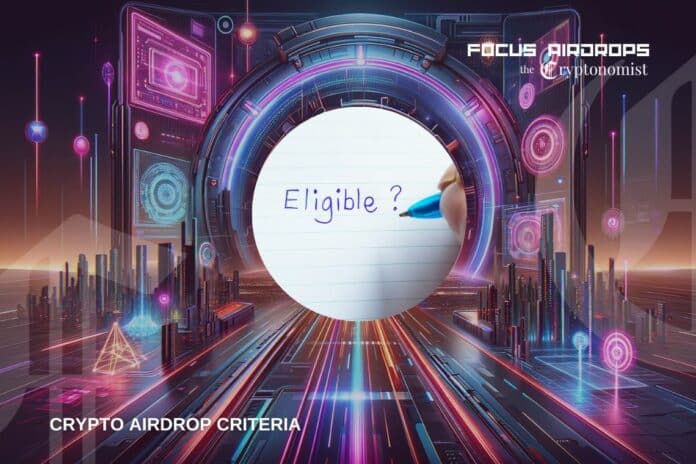In recent years, crypto airdrops have become increasingly popular as an incentive practice to attract new users to the new web3 infrastructures.
At the same time, the eligibility criteria, which establish the necessary requirements to be recognized as active users, change very quickly over time, making it complex to identify in advance what are the correct actions to be performed in order to be rewarded.
In this article we will see how these criteria are changing and how they influence the behavior of airdrop hunters.
The case of Starknet, which announced the distribution of STRK tokens to certain stakeholders of its network while simultaneously excluding a wide range of early adopters, is a striking example of how these conditions can change radically with each airdrop.
Summary
How eligibility criteria for crypto airdrops change over time: from Uniswap to the present day
When in 2022 Uniswap announced the airdrop of its native crypto, introducing a completely new practice in blockchain environments, all users who had interacted with the protocol were rewarded with a minimum of 400 UNI, up to a maximum of 2,100,000 UNI.
No particular action was required to redeem the airdrop other than meeting the only eligibility criterion eligibility which included executing at least one transaction on the platform (exchange, provide liquidity) or being a holder of the SOCKS coin before September 1, 2020.
Until today, projects that release an airdrop have significantly more complex criteria with which the lucky user categories and their respective allocation are determined.
Increasingly stringent criteria are necessary to eliminate or at least limit the presence of bots and sybil accounts that farm with hundreds of addresses simultaneously in an incorrect manner.
At the same time, however, it is necessary for users to be incentivized to carry out a high number of operations and to remain within a specific ecosystem for as long as possible.
Several projects after Uniswap have tried to devise a complex formula to fairly compensate all members of their community, taking into account various factors.
For example, Ethereum’s layer-2 Arbitrum distributed its ARB crypto to its users through an airdrop in March 2023, taking into account specific indicators for each wallet such as:
- bridge on Abitrum One and Arbitrum Nova
- number of transactions
- activity over time
- number of smart contracts used
- traded volume
The criteria established by the Arbitrum Foundation are considered by the crypto community as one of the best ever used for an airdrop, given the way in which they managed to reward all deserving users in proportion to the effort dedicated to using the infrastructure.
However, even these have been questioned by new requirements, which divert attention from mere on-chain activities (volumes, transactions) performed on a protocol or chain, to make room for external recognitions.
Several projects, in planning how the airdrop will be allocated to users, take into account conditions never used before such as having put in staking on official platforms ETH, TIA, OSMO, ATOM, SOL resources
This type of criterion allows for the even distribution of the airdrop to a community, without only the farmers who promptly disappear after claiming the crypto receiving the rewards.
It is clear, therefore, that to become eligible for every airdrop, it is not enough to do the homework and make some transactions to be sure to withdraw the final prize: the conditions change from project to project and the evolution of the cryptographic landscape determines in some way a continuous change of perspective.
The disappointment of the Starknet community for an unfair distribution of the STRK token
The Starknet airdrop is a striking case of how the arrival of new eligibility conditions may have shocked a good part of the cryptographic community, which did not expect such a criterion.
The team of the new Ethereum layer-2 announced a few days ago that it would distribute STRK tokens to a specific set of users:
- Members of the Starknet ecosystem
- Members of the StarkEx ecosystem
- Ethereum Stakers and early adopters
- Developer (web3 and non web3)
So far, nothing new, a hybrid provision that evaluates the amount of on-chain activity performed and the broader contribution given to Starknet as a developer or “honorary” member of Ethereum.
However, what has shaken many users, and has also prevented them from being eligible for the airdrop, is that to be considered “Starknet users” they had to have a minimum balance of 0.005 ETH in their wallet at the time of the snapshot, in addition to having carried out 5+ transactions within 3 months with a minimum volume of 100+ dollars.
Many expected stricter criteria, which would have rewarded only those who had performed many more transactions and exchanged much more value, and at the same time no one expected a constraint on the minimum wallet balance.
The result is that several farmers who spent months performing operations on the network then removed everything from those addresses and found themselves empty-handed at the time of the airdrop announcement.
At the same time, those who have done little for the ecosystem as users, but have left some change in their wallet, have qualified as eligible.
It goes without saying that several users have expressed their dissatisfaction and frustration with this team’s decision, to the point of threatening to abandon Starknet.
Furthermore, in this chaos that has unleashed the anger of the community, it is worth noting that several developers have received very important incentives, most of the time exceeding 10,000 STRK. For the first time in the history of an airdrop, completing a commit on Github has been more rewarding than interacting with a chain and performing various operations.
This demonstrates how every project intending to release a cryptocurrency through an airdrop can use entirely new eligibility criteria or criteria that have previously played a marginal role in determining user allocation.
Starknet teaches us that to successfully carry out the airdrop hunter activity, it is no longer enough to make a few transactions here and there on the new blockchains, but it is essential to thoroughly study the principles and objectives of each new project, dedicate oneself fully to the activities advertised by that group, and diversify one’s activity in the web3 world.




